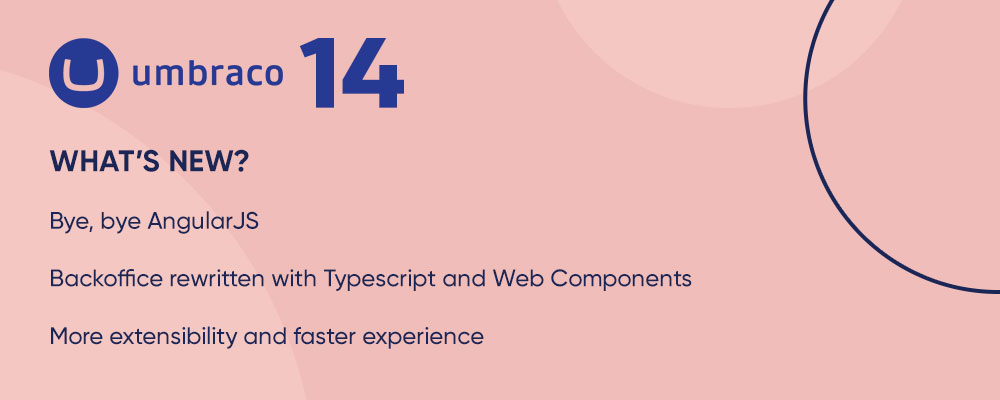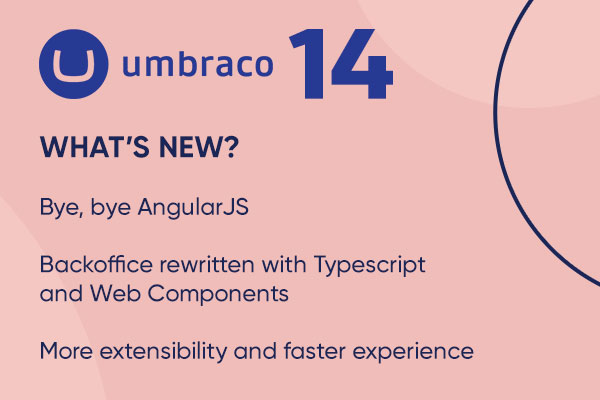Umbraco 14 has been out since May 30, marking a significant technological shift comparable to the transition to .NET Core in version 9. Change architects emphasize that most updates are "under the hood" and will be noticeable only to developers. The backoffice interface, in fact, remains familiar to users. However, moving away from legacy technology and increasing extensibility can have substantial business implications should you choose to go with "14" on your next digital adventure.
NEW BACKOFFICE IN UMBRACO 14 GETTING RID OF LEGACY TECH
The most important change in this platform version, announced for a long time, is the complete rewrite of the backoffice using new technology, losing AngularJS entirely. Recently, we wrote about how rapidly digital technology is changing today. Something is considered flavor of the week and highly recommended for new web apps, and three years later, you'll find threads on Reddit or Quora asking if it's dead already.
AngularJS was an extremely popular front-end JavaScript framework not too long ago. Though it remains relevant through the maintenance of countless projects, it is now considered legacy tech.
Legacy tech is prevalent throughout many digital projects; if well-maintained, it can run smoothly. However, relying on it too much is like having an old-timer car in good shape and a trusted repair shop nearby. Everything is fine until the workshop closes, the car fails, and another service tells you they no longer produce the necessary parts, leaving the only solution to buy a brand-new vehicle. This is what we call technological debt.
Umbraco 14's new backoffice replaces the well-served AngularJS with modern technologies: Web Components, TypeScript, LIT, and open-source Umbraco UI libraries. This improves the stability of your projects. Considering everything we wrote above about how rapidly technology becomes obsolete, you might wonder why we believe the new architecture won't be outdated in two or three years. The advantage is that it doesn't bind developers to any specific framework, thanks to Umbraco's "Extension-First Approach."
EXTENSION-FIRST APPROACH
In line with Umbraco's spirit of composability, the entire new backoffice has been designed to make adding extensions as easy as possible. In fact, nearly every part of the backoffice experience is technically built as an extension and implemented as such.
The Editor in Umbraco 14 has been reimagined as the Workspace, where you can create and manage your own sets of Workspace Views. The shift is not just a name change but a demonstration of the belief that Umbraco should adapt to the user, not vice versa. This new feature aims to significantly increase customization possibilities, putting you in the driver's seat of your digital projects.
The new architecture and UI allow you to add more custom or third-party extensions, and do so faster. It can also easily handle very complex websites, even those with 25,000 pages.
API LAYER IN UMBRACO 14
Umbraco 12 brought us the Content Delivery API, which was later changed to Media Delivery API, enhancing the platform's extensibility and flexibility. With version 14, a management-focused API was unveiled to provide additional advantages for developers working with various extensions and external solutions.
The new API introduces controllers to simplify content management and other system components. They facilitate the authorization of Umbraco objects from any system, enabling support for headless and composable environments.
Creators of new packages and extensions for Umbraco can also utilize any front-end framework compatible with Web Components, whether it's JS, React, or another option.
To extend the car metaphor, we could liken Umbraco to a Ford vehicle that we can enhance and maintain using components and extensions from Audi, Toyota, or Range Rover. This flexibility to replace and manage system components ensures the future-proofing of our website or digital experience, liberating us from the constraints of technological debt.
WHICH VERSION OF UMBRACO SHOULD YOU BE USING RIGHT NOW
We've covered this extensively in our previous article, but it's worth reminding you that Umbraco 14 is an STS (Standard-Term-Support) version, meaning it will receive support until mid-2025. STS versions featuring cutting-edge technology changes are best suited for projects aimed at continuous improvement, expansion, and feature introduction.
If you're working on such a project and the flexibility of the new Umbraco will benefit you, we're here to help with an upgrade strategy tailored to your current system. If you're currently using Umbraco 11, for instance, it's time for an upgrade anyway, so feel free to reach out, and we'll gladly assist you further.
Umbraco Developers needed? Looking to upgrade to Umbraco 14? We've got your back.



